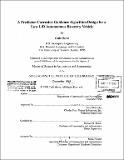| dc.contributor.advisor | Peter Neirinckx. | en_US |
| dc.contributor.author | Haroz, Carla (Carla Shariz), 1974- | en_US |
| dc.contributor.other | Massachusetts Institute of Technology. Dept. of Aeronautics and Astronautics. | en_US |
| dc.date.accessioned | 2006-02-02T18:46:21Z | |
| dc.date.available | 2006-02-02T18:46:21Z | |
| dc.date.copyright | 1998 | en_US |
| dc.date.issued | 1999 | en_US |
| dc.identifier.uri | http://hdl.handle.net/1721.1/31085 | |
| dc.description | Thesis (S.M.)--Massachusetts Institute of Technology, Dept. of Aeronautics and Astronautics, February 1999. | en_US |
| dc.description | Includes bibliographical references (p. 171). | en_US |
| dc.description.abstract | The Precision Landing Reusable Launch Vehicle (PL-RLV) is a low L/D, 2-stage craft with a mission plan that calls for low cost, speedy retrieval, and quick turn-around-times for successive flights. A guidance scheme that best adheres to these goals and captures the vehicle's capability is desired. During re-entry, the PL-RLV's second stage, the Precision Landing Vehicle 2 (PLV-2), will perform a reversal maneuver. This thesis concentrates on a possible re-entry guidance scheme for the PLV-2 during the terminal phase, the time from the completion of the reversal until the landing system parachutes are deployed. A simple bank-to-steer algorithm is suggested. The angle of attack is trimmed, and the bank angle (or bank rate) remains as the only means for control. The algorithm controls the time history of the vehicle's bank angle and tunes the bank angle history to meet landing and fuel requirements. This versatile guidance approach employs predictor-corrector methods. The guidance scheme presented generates a possibility of bankrate profiles within limitations that could be used for target acquisition. Selection of a robust target location and the nominal bankrate profile which will yield a minimum target miss are investigated. Testing shows the trade-offs between fuel cost and landing capability. Dispersion testing with winds and density are also performed. The predictor-corrector combination can yield target miss distances on the order of hundreds of feet or less. Open-loop and closed-loop results display the guidance system's ability to capture the PLV-2's capability in the presence of dispersions while still meeting system requirements. | en_US |
| dc.description.statementofresponsibility | by Carla Haroz. | en_US |
| dc.format.extent | 171 p. | en_US |
| dc.format.extent | 6141944 bytes | |
| dc.format.extent | 6163491 bytes | |
| dc.format.mimetype | application/pdf | |
| dc.format.mimetype | application/pdf | |
| dc.language.iso | eng | en_US |
| dc.publisher | Massachusetts Institute of Technology | en_US |
| dc.rights | M.I.T. theses are protected by copyright. They may be viewed from this source for any purpose, but reproduction or distribution in any format is prohibited without written permission. See provided URL for inquiries about permission. | en_US |
| dc.rights.uri | http://dspace.mit.edu/handle/1721.1/7582 | |
| dc.subject | Aeronautics and Astronautics. | en_US |
| dc.title | A predictor-corrector guidance algorithm design for a low L/D autonomous re-entry vehicle | en_US |
| dc.title.alternative | Predictor-corrector guidance algorithm design for a low lift-over-drag autonomous re-entry vehicle | en_US |
| dc.type | Thesis | en_US |
| dc.description.degree | S.M. | en_US |
| dc.contributor.department | Massachusetts Institute of Technology. Department of Aeronautics and Astronautics | |
| dc.identifier.oclc | 46605171 | en_US |
